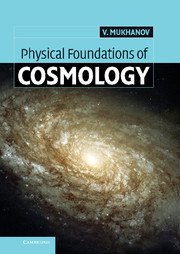Book contents
- Frontmatter
- Contents
- Foreword by Professor Andrei Linde
- Preface
- Acknowledgements
- Units and conventions
- Part I Homogeneous isotropic universe
- Part II Inhomogeneous universe
- 6 Gravitational instability in Newtonian theory
- 7 Gravitational instability in General Relativity
- 8 Inflation II: origin of the primordial inhomogeneities
- 9 Cosmic microwave background anisotropies
- Bibliography
- Index
9 - Cosmic microwave background anisotropies
from Part II - Inhomogeneous universe
Published online by Cambridge University Press: 05 September 2012
- Frontmatter
- Contents
- Foreword by Professor Andrei Linde
- Preface
- Acknowledgements
- Units and conventions
- Part I Homogeneous isotropic universe
- Part II Inhomogeneous universe
- 6 Gravitational instability in Newtonian theory
- 7 Gravitational instability in General Relativity
- 8 Inflation II: origin of the primordial inhomogeneities
- 9 Cosmic microwave background anisotropies
- Bibliography
- Index
Summary
After recombination, the primordial radiation freely streams through the universe without any further scattering. An observer today detects the photons that last interacted with matter at redshift z ≈ 1000, far beyond the stars and galaxies. The pattern of the angular temperature fluctuations gives us a direct snapshot of the distribution of radiation and energy at the moment of recombination, which is representative of what the universe looked like when it was a thousand times smaller and a hundred thousand times younger than today.
The first striking feature is that the variations in intensity across the sky are tiny, less than 0.01% on average. We can conclude from this that the universe was extremely homogeneous at that time, in contrast to the lumpy, highly inhomogeneous distribution of matter seen today. The second striking feature is that the average amplitude of the inhomogeneities is just what is required in a universe composed of cold dark matter and ordinary matter to explain the formation of galaxies and large-scale structure. Moreover, the temperature autocorrelation function indicates that the inhomogeneities have statistical properties in perfect accordance with what is predicted by inflationary models of the universe.
In a map showing the microwave background temperature across the sky, the features subtending a given angle are associated with physics on a spatial scale that can be computed from the angle and the angular diameter distance to the last scattering surface.
Information
- Type
- Chapter
- Information
- Physical Foundations of Cosmology , pp. 356 - 409Publisher: Cambridge University PressPrint publication year: 2005
